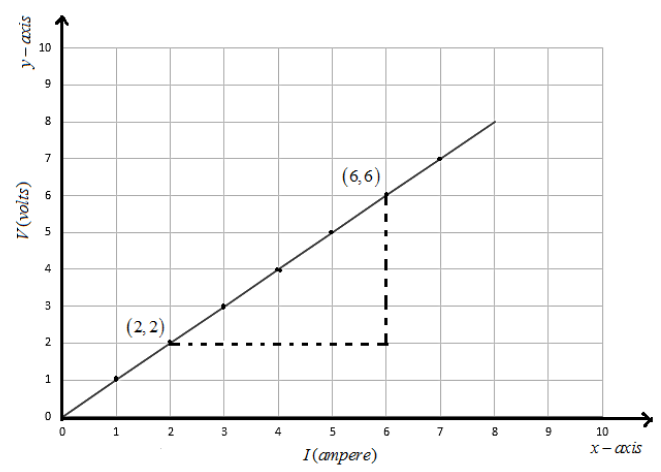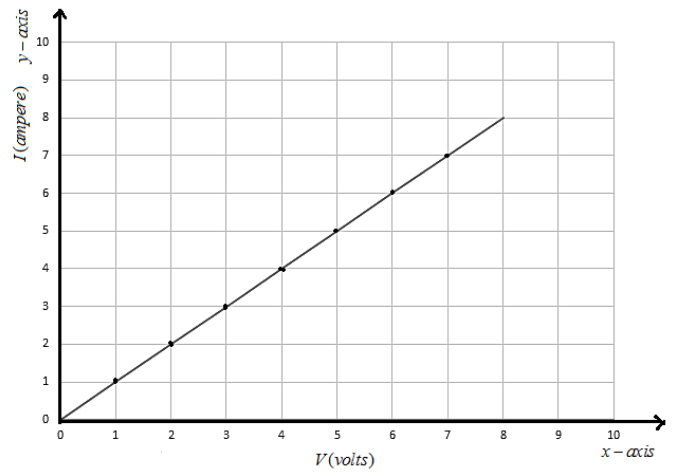
(a) Draw a \[V - I\] graph for a conductor obeying Ohm’s law.
(b) What does the slope of the \[V - I\] graph for a conductor represent ?
(c) Draw a \[I - V\] graph for a linear resistor. What does its slope represent ?
Answer
510.3k+ views
Hint: Here, we know that the graph between the potential difference and the current is in a straight line. It is because the graph between potential and current obeys the ohm’s law. Here, we have to draw the graphs and derive the slope of the straight line.
Complete step by step answer:
(a) Ohm’s law: It states that the current through a conductor between two points is directly proportional to the voltage across the two points and it is given by \[V = IR\]; \[V\] is the potential difference, \[I\] is the current and \[R\] is the resistance. Let us represent this ohm’s law in graph below as:

(b) The slope of the \[V - I\] represents the resistance \[R\] of the conductor as in the graph above is based on the ohm’s law we know that \[V\alpha I\] and \[V = IR\]. Also, the slope of the above graph represents \[R = \dfrac{V}{I}\] and it is known as the resistance of the conductor for which the graph is represented.
(c) Here, we will represent the \[I - V\] graph of the linear resistance as given below:

Now we have to find out what the slope of this graph represents as below:
Slope of this graph is given by:
\[slope = \dfrac{{\Delta I}}{{\Delta V}}\]
And this is the reciprocal of the resistance of the conductor. But reciprocal of resistance of the conductor given the conductance of the conductor. Thus, the slope of the \[I - V\] graph represents conductance of the conductor with linear resistance.
Note: We observed the two characteristics of representation of slope of the \[V - I\] and \[I - V\] graphs. These slopes show the two characteristics of a conductor for which we have applied some potential and current flowing through it that \[V - I\] gives resistance and \[I - V\] gives conductance of the conductor.
Complete step by step answer:
(a) Ohm’s law: It states that the current through a conductor between two points is directly proportional to the voltage across the two points and it is given by \[V = IR\]; \[V\] is the potential difference, \[I\] is the current and \[R\] is the resistance. Let us represent this ohm’s law in graph below as:

(b) The slope of the \[V - I\] represents the resistance \[R\] of the conductor as in the graph above is based on the ohm’s law we know that \[V\alpha I\] and \[V = IR\]. Also, the slope of the above graph represents \[R = \dfrac{V}{I}\] and it is known as the resistance of the conductor for which the graph is represented.
(c) Here, we will represent the \[I - V\] graph of the linear resistance as given below:

Now we have to find out what the slope of this graph represents as below:
Slope of this graph is given by:
\[slope = \dfrac{{\Delta I}}{{\Delta V}}\]
And this is the reciprocal of the resistance of the conductor. But reciprocal of resistance of the conductor given the conductance of the conductor. Thus, the slope of the \[I - V\] graph represents conductance of the conductor with linear resistance.
Note: We observed the two characteristics of representation of slope of the \[V - I\] and \[I - V\] graphs. These slopes show the two characteristics of a conductor for which we have applied some potential and current flowing through it that \[V - I\] gives resistance and \[I - V\] gives conductance of the conductor.
Recently Updated Pages
Master Class 12 Business Studies: Engaging Questions & Answers for Success

Master Class 12 Economics: Engaging Questions & Answers for Success

Master Class 12 English: Engaging Questions & Answers for Success

Master Class 12 Maths: Engaging Questions & Answers for Success

Master Class 12 Social Science: Engaging Questions & Answers for Success

Master Class 12 Chemistry: Engaging Questions & Answers for Success

Trending doubts
What are the major means of transport Explain each class 12 social science CBSE

Which are the Top 10 Largest Countries of the World?

Draw a labelled sketch of the human eye class 12 physics CBSE

How much time does it take to bleed after eating p class 12 biology CBSE

Explain sex determination in humans with line diag class 12 biology CBSE

Differentiate between homogeneous and heterogeneous class 12 chemistry CBSE




